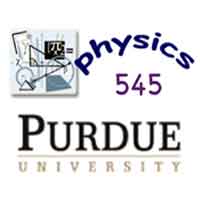Lecture 14: Band Bending
We answer that question: can you use a p-n junction to run a light bulb?
More about the p-n junction: thermal equilibrium, and recombination of carriers.
When a voltage is applied to a p-n junction, large currents flow if the junction is "forward biased", but if you switch the sign of the applied voltage, the current response is very small. You can use this to build a rectifier. We also discuss band bending, and calculate the form of the voltage across the junction using Poisson's equation. Why do we say the bands bend? When any 2 substances are in contact and achieve equilibrium, they trade particles until the chemical potentials are equal. The same thing happens for the holes and electrons in the p-n junction -- particles diffuse across the junction until the chemical potentials are equal. This causes the built-in voltage, and the conduction and valence bands "bend" in response.
p-n Junctions are in Ch. 17 of Kittel, pgs. 503-513.
Even better, see Vol III, Ch. 14 of the Feynman Lectures.
Lecture Audio
More about the p-n junction: thermal equilibrium, and recombination of carriers.
When a voltage is applied to a p-n junction, large currents flow if the junction is "forward biased", but if you switch the sign of the applied voltage, the current response is very small. You can use this to build a rectifier. We also discuss band bending, and calculate the form of the voltage across the junction using Poisson's equation. Why do we say the bands bend? When any 2 substances are in contact and achieve equilibrium, they trade particles until the chemical potentials are equal. The same thing happens for the holes and electrons in the p-n junction -- particles diffuse across the junction until the chemical potentials are equal. This causes the built-in voltage, and the conduction and valence bands "bend" in response.
p-n Junctions are in Ch. 17 of Kittel, pgs. 503-513.
Even better, see Vol III, Ch. 14 of the Feynman Lectures.
Lecture Audio

